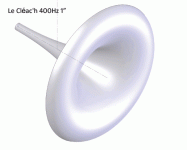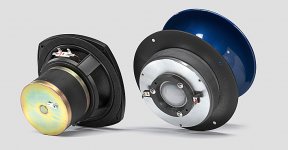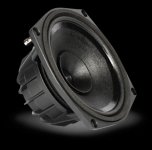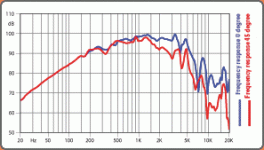Do anyone have experience with horn loading dome midranges? In this case Dayton RS52AN in a Le Cleach horn pictured below.
Attachments
Avantgarde Duo to my knowledge has big midrange dome.
Seems like a cone driver 🙂
Attachments
I'm experimenting with that exact driver right now in a waveguide. I started a thread here: TangBand 75-1558SE on a Waveguide with Measurements - Techtalk at Parts-Express.com
Haven't finished experimenting. I found one alignment that had potential and a bunch that sucked. I was pretty surprised at the variable results for such seemingly small changes.
Haven't finished experimenting. I found one alignment that had potential and a bunch that sucked. I was pretty surprised at the variable results for such seemingly small changes.
Just realized you are talking about mating it too a real (big) horn. My thread may not help much with that. Domes don't match a standard horn unless it was designed for it in the first place.
Just realized you are talking about mating it too a real (big) horn. My thread may not help much with that. Domes don't match a standard horn unless it was designed for it in the first place.
The pictured horn is a 1" throat, so with a 3" dome it will be much shorter, still skeptical though since after shortening it there is no way back...

Found this written by Bruce Edgar, interessting reading:
"Horn loading of domes is a reocurring subject on AA. I've experimented with them off and on for the last 20 years. Here are a number of conclusions from that research.
The frequency range is highly dependent on the driver. Even though these domes are designed as tweeters, they are meant to be mass loaded drivers. The diapragm/voice coil mass will limit the top end. In my first experiments, described in the Speaker Builder article "The Edgar Midrange Horn", the dome's response (90dB sens.) shifted from being a tweeter response (2-20 kHZ) to a typical midrange response(500 Hz-5 kHz at 100 dB sens.). This phenomenon demonstrates Small's Law about the efficiency-bandwidth product being a constant. When you horn load a driver, the bandwidwidth goes down and the efficiency goes up.
The top end response of the dome/horn can be extended if there is some suspension control of the diaphragm. Suspension control will force the driver diaphragm breakup modes to remain in circular modes over an extended range which will excite a horn. For example the T-35 diaphragm is a phenolic dome with a voice coil cemented to it. The suspension is very rigid. The mass rolloff frequency is around 3 kHz, yet the horn response is above 10kHz. The top end response is all breakup modes. This trick is used in many cheap horn tweeters to extend the top end.
Unfortunately, you can't identify which drivers have the suspension stiffness from any of the published data. It can only be found from testing. I used to have a closet full of oddball tweeters that I experimented with over the years, trying to find the ideal candidate. The best one, already mentioned in a post below, was the Dynaudio D-54 dome. Unfortunately, it is not available any more. But it was the best sounding dome driver on a horn that I ever found.
The downside of dome/horn combos is that the domes were very suseptible to burnout after a period of use. Dome tweeters are designed for operation above 2 kHz and not down to 500 Hz. I was using domes in my early Slimline midranges, but I had to switch over to cone mids for better reliability. Again, the best cone horn drivers for horns had some degree of suspension control. But all the cone drivers would usually crap out at 3 kHz. The old JBL LE-5 alnico driver with a concave dustcover was the only driver that could go up to 5 kHz reliably. In the present Slimline, I use the JBL 104H which only goes up to 3 kHz.
As for advice about the present selection of dome/cone drivers, I have none because I haven't tried any lately, except for one driver- the Fostex FE 126. I tried it out on my rectangular 300 Hz tractrix horn and was disappointed that it only went up to 2.5 kHz. I doubt if any of the conical horns suggested will improve the top end response from what my experiments have suggested. But again keep on doing experiments, you never know what serendipidous combination of horn and driver will work.
Bruce "
If you have some paper cones available around , ie membranes , they should work for your purpose.
Sorry I didn't look at your first picture , which is too narrow in the throat ,and too long , for a dome .
Sorry I didn't look at your first picture , which is too narrow in the throat ,and too long , for a dome .
Do anyone have experience with horn loading dome midranges? In this case Dayton RS52AN in a Le Cleach horn pictured below.
horn loading that would not be very smart.
waveguide loading it would be a good idea.
Hello,
Why that?
A dome loudspeaker will perform better with some acoustical loading.
A good horn will provide a better loading than a waveguide to a dome loudspeaker.
One of the classical example is The Dynaudio D-54 mounted on a tractrix horn.
"The Dynaudio D-54 in a Edgarhorn is reputed by the "Sound Practices" group to be the finest midrange in the world."
http://ai.kaist.ac.kr/~suh/DIY/feedback.html
Best regards from Paris, France
Jean-Michel Le Cléac'h
horn loading that would not be very smart.
waveguide loading it would be a good idea.
Why that?
A dome loudspeaker will perform better with some acoustical loading.
A good horn will provide a better loading than a waveguide to a dome loudspeaker.
One of the classical example is The Dynaudio D-54 mounted on a tractrix horn.
"The Dynaudio D-54 in a Edgarhorn is reputed by the "Sound Practices" group to be the finest midrange in the world."
http://ai.kaist.ac.kr/~suh/DIY/feedback.html
Best regards from Paris, France
Jean-Michel Le Cléac'h
sorry JmLc , I don't pretend that I'm right as you have the numbers to say so , although every case is different and should be listened first.
For me it (may) matters also if the dome midrange is flush mounted or not. So that 1-2 mm baffle non alignment counts. For that particular shape of the dome ,the reflections of the first part of the throat like in Defos post #1 would cut more that 50% of energy radiated , producing only a narrow beam , which often is opposite to the wide dispersion we're seeking.
Regards from the city of the very big dome , Florence!
For me it (may) matters also if the dome midrange is flush mounted or not. So that 1-2 mm baffle non alignment counts. For that particular shape of the dome ,the reflections of the first part of the throat like in Defos post #1 would cut more that 50% of energy radiated , producing only a narrow beam , which often is opposite to the wide dispersion we're seeking.
Regards from the city of the very big dome , Florence!
Hello,
Why that?
A dome loudspeaker will perform better with some acoustical loading.
A good horn will provide a better loading than a waveguide to a dome loudspeaker.
One of the classical example is The Dynaudio D-54 mounted on a tractrix horn.
"The Dynaudio D-54 in a Edgarhorn is reputed by the "Sound Practices" group to be the finest midrange in the world."
http://ai.kaist.ac.kr/~suh/DIY/feedback.html
Best regards from Paris, France
Jean-Michel Le Cléac'h
i agree *some* acoustical loading ( waveguide ) will do a dome good.
but if you're going to *horn* load something - why not use a driver *designed* for horn use - namely a compression driver ?
now i am not saying that it *can't* work. it is *possible* that some dome in some horn may work well but the approach itself seems misguided.
Last edited:
Member
Joined 2003
The RS52AN is a really great driver for the price, but it is an aluminum dome which you say you don't want to use??? With a good system implementation, it sounds quite smooth and very detailed...not harsh at all.
What are your objectives? Polar pattern? Though I haven't tried it, the RS52 might make a good constant directivity candidate using a large conical waveguide with a generous roundover at the mouth.
What are your objectives? Polar pattern? Though I haven't tried it, the RS52 might make a good constant directivity candidate using a large conical waveguide with a generous roundover at the mouth.
The RS52AN is a really great driver for the price, but it is an aluminum dome which you say you don't want to use??? With a good system implementation, it sounds quite smooth and very detailed...not harsh at all.
What are your objectives? Polar pattern? Though I haven't tried it, the RS52 might make a good constant directivity candidate using a large conical waveguide with a generous roundover at the mouth.
Yeah, after the reviews I figured it would do.
The objective is dispersion controll and high sensitivity for good dynamics with no harshness. Dome midranges is also 4 times less expensive then Radian 2" compression drivers, which would be my choice because of mylar suspension and aluminium diaphragm (better then titanium at least...).
The pictured horn in first post will be 22 cm long after cut and as you see it has a large roundover.
If you search over at htguide, I posted some measurements from some experiments I did a while back with the RS52 in a waveguide. I was working towards using it as a Unity arrangement, although I never really got the mids dialed in. The RS52 looked promising in the waveguide, although if I remember correctly it didn't really extend the low end particularly - I may be mis-remembering though , as it was a while ago.
The RS52AN is a really great driver for the price, but it is an aluminum dome which you say you don't want to use??? With a good system implementation, it sounds quite smooth and very detailed...not harsh at all.
What are your objectives? Polar pattern? Though I haven't tried it, the RS52 might make a good constant directivity candidate using a large conical waveguide with a generous roundover at the mouth.
if you cosider that piece of c4ap Dayton against another 2" metal dome
Welcome to E-Speakers.com - Very High End Loudspeaker Components
in a horn i think you will understand how ridiculous it is.
i have that dayton. i wanted to throw it out as soon as i tried it. i suppose if you open it up, put some damping in the chamber then use a $3,000 FIR digital crossover with 300db/oct lowpass on it then it will sound quite good !
but it's so much easier to just toss it in the trash where it belongs.
i bought that dayton to use in my car. i bought it along with some SPL competition car audio bullet tweeters. in the end i ended up using the bullets and not using the dayton because i couldn't stand it. i went with a scan-speak 1.5" soft dome instead.
Last edited:
These argumentations are useless since a midrange speaker uses WG or a horn to match the other drivers characteristics , unless you felt in love with a recorded voice of an eunuchus and that's the only thing you want to hear 😱
i wonder if anybody except GOTO unit makes low midrange compression drivers ?
i would probably never buy GOTO unit even if i could afford it. it just looks like a rip off.
with drivers like Beyma TPL you pay for performance. it costs 10 times as much as a regular tweeter and it gives you 10 times the performance. same with a TAD compression driver.
but nobody seems to seriously approach compression midranges ...
?
i would probably never buy GOTO unit even if i could afford it. it just looks like a rip off.
with drivers like Beyma TPL you pay for performance. it costs 10 times as much as a regular tweeter and it gives you 10 times the performance. same with a TAD compression driver.
but nobody seems to seriously approach compression midranges ...
?
- Status
- Not open for further replies.
- Home
- Loudspeakers
- Multi-Way
- Horn loaded dome midrange



